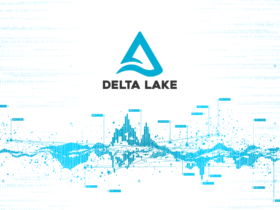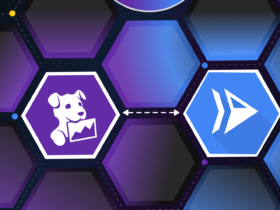
Hybrid and multi cloud deployment models are the new and normal for enterprise IT organizations. With these mixed environments, new challenges around data management emerge. In this article we define the Data Fabric and its architecture, discuss about architecture layers and reveal how data fabric is evolving.
IT professionals today are seeking ways to accelerate innovation by taking advantage of technology trends with cloud, object storage, open source, converged infrastructures, virtualization, flash, containers, and software-defined storage, to name a few.
Managing data in hybrid cloud architectures that have evolved into incompatible data silos brings additional challenges which includes Protecting data and addressing security issues. Wherever an organization’s data resides, IT is still responsible for data security, data protection and data governance to make sure of regulatory compliance.
Inability to move data, when an organization’s data is in a particular cloud, it can be difficult or impossible to move it to a different one. Difficult to manage data consistently, each environment has a different set of tools, APIs, and management software that make it difficult to apply consistent policies to data.
IT staff should have the minimum knowledge of how to use all these tools and applications effectively. Limited choice, new technologies and services that do not integrate with existing environments are difficult to adopt.
As a result, IT is limited in its technology choices, affecting its ability to exploit the capabilities of new and existing environments. Lack of control, data is a critical asset for successful organizations. IT must be the stewards of that data no matter where it is.
Storing that data in a cloud where there is little visibility into how it is protected and governed can put businesses at risk. To overcome these challenges, IT needs a secure, seamless way to manage applications and data across clouds, regardless of their underlying storage systems.
Key Points:
- Data Fabric is an emerging solution to the complexities of modern data management. It combines architecture, technology, and services to automate much of data engineering, operations, and orchestration.
- Almost everyone today operates multi-cloud and cloud-hybrid systems. Managing across these systems needs a single, unified data management platform.
- Data Fabric provides a single, unified platform for data management across multiple technologies and deployment platforms.
- No single vendor provides a complete data fabric solution today. Choose the right technologies to weave your data fabric. Interoperability is a key consideration.
Trouble with Data Management:
Data management has become increasingly complex over recent years as the variety of deployment platforms, and data use cases expands. Today’s data management challenges include data silos, data engineering bottlenecks, operationalization difficulties, and orchestration of data systems in runtime environments.
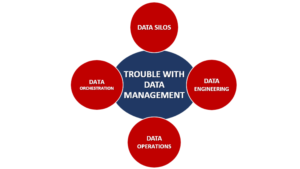
Data Silos:
When the data is siloed across multiple cloud platforms and stored in on-premises databases, it becomes difficult to find, blend, and integrate when needed. The complex deployment landscape illustrates typical deployments today.
Data silos across the Ecosystem:
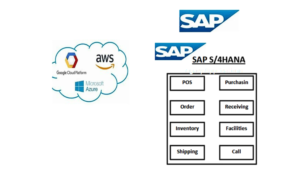
Data Engineering:
Data Engineer is a part of database development (building the databases that implement data warehouses, data lakes and analytical sandboxes) and software engineer (building the processes, pipelines, and services that move data through the ecosystem and makes is available to data consumers). One goal of data fabric is to automate much of data engineering to increase reuse and repeatability, and to expand data engineering capacity.
Data Operations:
DataOps is a data management approach that is designed for rapid, reliable, and repeatable delivery of production-ready data and fully operational analytics. One goal of data fabric is to fully support the automation needed for DataOps success, with ability to automate across on-premises, cloud and hybrid data ecosystems.
Data Orchestration:
Execution environments have many of the same challenges as data environments. Pushing processing to data locations results in on-premises, cloud, multicloud, hybrid and edge environments for runtime processing of data. Separating computation from data and scaling each independently is fundamental to operate this extreme of distributed and parallel processing. End-to-end data pipelines often span multiple execution environments. Managing data access and processing across these complex environments requires attention to configuration and coordination, workflow and scheduling, cross-platform interoperability, fault tolerance, and performance optimization. One goal of data fabric is to support automation across the many dimensions of data orchestration.
Data Fabric
A design concept that serves as an integrated layer (fabric) of data and connecting processes. A data fabric utilizes continuous analytics over existing, discoverable, and inferenced metadata assets to support the design, deployment, and utilization of integrated and reusable data across all environments, including hybrid and multi-cloud platforms.The Data Fabric is an architectural approach or a methodology that allows you to govern all sources of data whether it is on-premises systems, multiple cloud environments, SaaS applications, by adding a virtualization layer without moving or copying data.
Data integration strategy and tools play a key role in building a robust data fabric. Using Data fabric for data management allows you to access data across systems and copy or move data when needed using a strategy and tools. Data Fabric focuses on the synchronization of information across data pipelines by using active metadata by implementing processes that make data sharing and access easier and avoids data silos and data duplication across systems. This approach makes data access easier, efficient and significantly improves decision-making.
Broad Scope of Data Management:
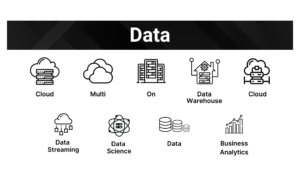
Five Major Principles of Data Fabric
1.Control: Securely retain control and governance of data regardless of its location on-premises, near the cloud, or in the cloud.
2.Choice: Choose cloud, application ecosystem, delivery methods, storage systems, and deployment models, with freedom to change.
3. Integration: Enable the components in every layer of the architectural stack to operate as one while extracting the full value of each component.
4.Access: Easily get data to where applications need it, when they need it, they can use it.
5.Consistency: Manage data across multiple environments using common tools and processes regardless of where it resides. When a data fabric delivers on these principles, it enables customer to increase efficiency, improve IT responsiveness, and ultimately accelerate innovation.
Features of Data Fabric
The complexities of modern data management expand rapidly as new technologies, new kinds of data and new platforms are introduced. As data becomes increasingly distributed across in-house and cloud deployments the work of moving, storing, protecting, and accessing data becomes fragmented with different practices depending on data locations and technologies.
Changing and bolstering data management methods with each technological shift is difficult and disruptive. As technology innovation accelerates it will quickly become unsustainable. Data fabric can serve to minimize disruption by creating a highly adaptable data management environment that can quickly adjust as technology evolves.
Unified data management: Providing a single framework to manage data across desperate deployments reduces the complexity of data management.
Unified data access: Providing a single and seamless point of access to all data regardless of structure, database technology, and deployment platform creates a cohesive analytics experience working across data storage silos.
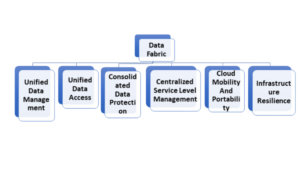
Consolidated data protection: Data security, Backup and Disaster recovery methods are built into the data fabric framework. They are applied consistently across the infrastructure for all data whether deployed in cloud, multi-cloud, hybrid or on-premises.
Centralized service level management: Service levels related to responsiveness, availability reliability, and risk containment can be measured, monitored and managed with a common process for all types of data and all deployment options.
Cloud mobility and portability: Minimizing the technical differences that lead to cloud service lock-in and enabling quick migration from one cloud platform to another supports the goal of a true cloud-hybrid environment.
Infrastructure resilience: Decoupling data management processes and practices from specific deployment technologies makes for a more resilient infrastructure. Whether adopting edge computing, GPU databases, or technology innovations not yet known, the data fabric’s management framework offers a degree of “futureproofing” that reduces the disruptions of new technologies. New infrastructure endpoints are connected to the data fabric without impact to existing infrastructure and deployments.
Advantages and Utilization Scope in Industry:
Data Fabric delivers unified data management across clouds. With data fabric, organizations can increase efficiency, improve IT responsiveness, and ultimately accelerate innovation.
Enterprise CEOs: Data Fabric enables enterprise CEOs to foster an environment that stimulates innovation. They can improve the use of business resources through agility. Agility enables an organization to move at the speed of smaller companies without sacrificing the ability to meet the business and compliance requirements of their industry. They can have confidence that the organization’s data is secure.
Enterprise CIOs: When it comes to meeting the needs of the business, CIOs need to maintain their existing environments and security posture while adopting promising technologies. With Data fabric, CIOs gain the freedom to make the best decisions for the business by making sure of secure access to data wherever it is needed and accelerating innovation with fewer resources. As hybrid cloud becomes the new normal for IT, CIOs need to protect, manage, and make sure of compliance of their organizations’ data no matter where it resides.
IT Architects: Heads of IT infrastructure need to satisfy diverse service-level objectives (SLOs). Workloads require different availability, performance, cost, security, and access. With Data fabric, IT architects have flexibility in their design of hybrid cloud architectures. They can ensure access control by providing the security that the organization requires with the data access users need.
Application Owners: The need for secure, rapid software development is driving fast adoption of hybrid cloud by application development teams. Setting up infrastructure for new projects in the cloud is fast and affordable; it gives the ability to adopt a DevOps paradigm and gives pilot projects the freedom to fail. When costs outstrip advantages, application owners can bring development and/or production environments back to their data centres.
Storage Architects: The Data Fabric extends the reach of storage architects and administrators into cloud architectures. It gives them the opportunity to leverage their existing skills and operational experience to take advantage of new deployment models that are on the leading edge of technology. With new tools at their disposal, they have more freedom to enable their users to be more productive and innovate in new ways.
Cloud Service Providers: Cloud service providers (SPs) seek to scale their business up, drive costs down, and onboard customers quickly and easily. With data fabric, SPs can build an efficient and dependable infrastructure that scales with demand. Operations are completely automatable, whether the cloud orchestration framework is commercial, open source, or custom built. Customers can be on boarded by enabling them to extend their data fabrics to the SP cloud, giving them control of their data while they utilize cloud services.
Continued – A Deep Dive into Data Fabric Architecture and Its Key Components


